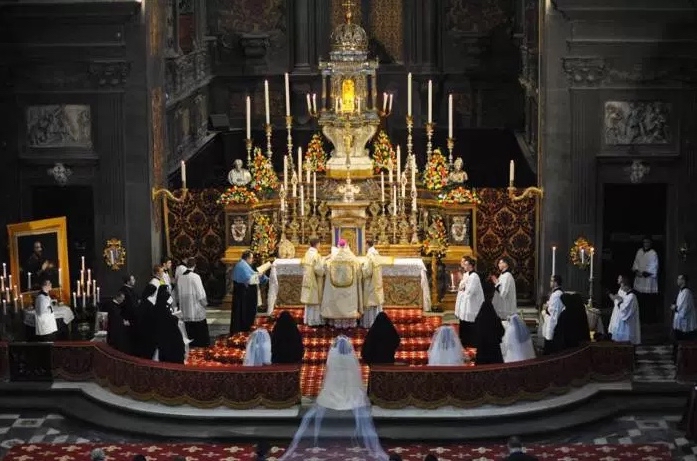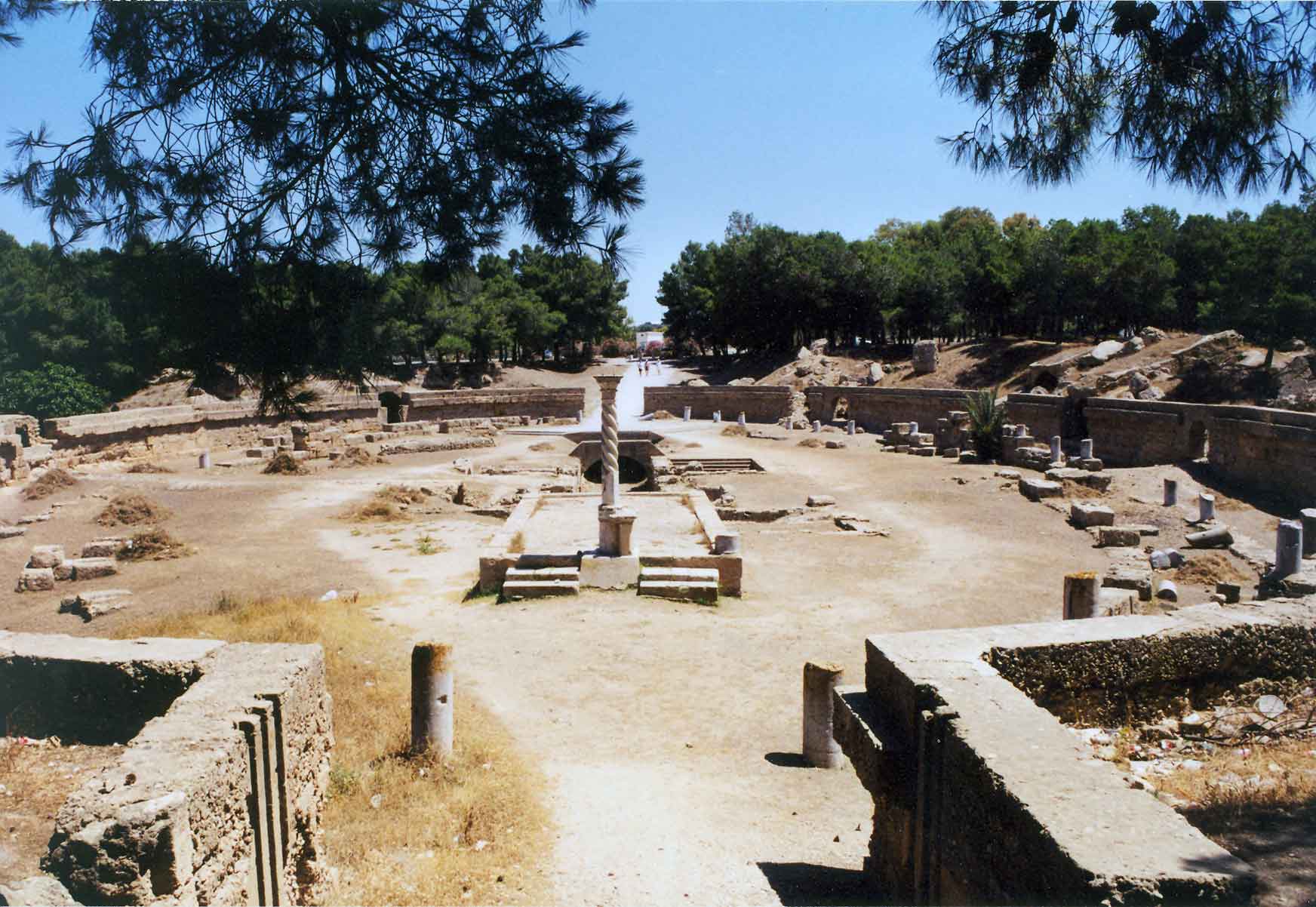By Katy Hounsell-Robert
I am at the noisy music festival in the amphitheatre in present day Carthage. As the jasmine sellers weave their way up and down the crowded broad stone steps, the intoxicating fragrance of jasmine fills the warm evening air and everyone seems to be enjoying the show and taking part in one way or another. Men in traditional long gowns leap up every now and again to dance on the steps while groups of girls chat solidly through the whole performance. It is not difficult to visualise St Augustine as a young student at Carthage University in the late fourth century as a spectator here, laughing at the comedies of his fellow countryman Apuleius and weeping at Virgil's "Dido and Aeneas".
Several hundred years before Augustine, the amphitheatre had been the scene of many North African Christian martyrs torn apart by lions for refusing to acknowledge the Roman Emperor as a God, the best known being the young matron Perpetua and servant girl Felicity, now on our calendar of saints. Happily the Emperor Constantine made Christianity the state religion in 313 and so by the time Augustine was born in 354 in Thagaste, now Souk Ahras in present day Algeria, his devout Catholic mother Monica was able to take her son to church while his pagan father, Patricius, got on with running their small farm.
Despite being neglected and allowed to fall into ruins by the Arabs and later the Ottomans, the ruins are substantial enough to visit in the warm sunshine and get a good picture of Augustine's life here. There are the Baths of Antoninus where Augustine, his great friend Nebridius and fellow students would relax and discuss philosophy and nearby the magnificent circular Punic port where they watched foreign ships come in and from where Augustine sailed over to Rome. It is also a must to climb Byrsa Hill, site of the original city of Carthage built by Dido, which gives the most beautiful views over the blue Mediterranean sea and where the wealthy, then including the Roman Governor, lived and still live. The main forum was also on Byrsa Hill where Augustine attended lectures at the University and later taught. Now there is the nineteenth century Cathedral of St Louis, built by the French, which has mosaics depicting Augustine's life and the National Museum of Carthage which contains most of his works.
It would have been too hot and bright to read outside during the day but in the many cafés Augustine read tirelessly the Greek philosophers in Latin and more recent writings including Cicero's Hortensius which advised ambitious young men to seek firstly not fame or wealth but God. Material rewards would follow naturally. Here in Carthage, despite his mother's wishes for him to be Catholic, he became a learner in the Manichee Faith which incorporated Christianity but taught that life was composed of good and evil with evil continually battling for supremacy. Leading a celibate life and being vegetarian would help overcome evil and bring one to God and truth. He was already in a passionate relationship with a woman which lasted 15 years and produced a son but he seemed to be accepted.
He initially moved on to a teaching job in Rome and through a Manichee connection became the Emperor's speech writer in Milan and tutor to his son. To improve his skills in oratory he listened to sermons preached by the charismatic Bishop Ambrose in whom he found a man steeped in Greek philosophy which seemed to make sense of Christianity. He became totally obsessed as he did with everything he believed in, and prepared for a Catholic baptism. Ideas of becoming a famous orator or senator and a wealthy marriage were abandoned and he made the long trek along the Merjerdha river through wooded hilly countryside and fresh springs back to his homeland to found a monastery and later became Bishop of Hippo Regius, now Annaba. He always loved Carthage and in 30 years visited 31 times to preach and preside over councils .
I sat with friends sipping mint tea in a café in Sidi Bou Said discussing what made Augustine be remembered and have such an influence today.
"His writings," said one friend. "His 'Confessions' which must have been a best seller then. His 'City of God' and the thousands of articles and sermons. There is so much wisdom there and so many quotes – not forgetting ''Oh, Lord, give me chastity, but do not give it yet'."
Another friend said: "He showed that he was a vulnerable human being, a man of the people. He didn't like wearing elaborate garments, which offended his comparatively humble back ground. He always wore a simple black gown and he wanted the ordinary man and women to know that the love of God was not just for the privileged few but for everyone."
He was also very open minded about women then too, added a woman friend: "He said if a woman, Eve, could be blamed for the fall of mankind, another woman cancelled out the sin by bringing forth the redeemer of mankind. And he allowed his sister to open a convent nearby in Annaba. He spoke up against husbands beating their wives, as they did then."
We all agreed he was man who hated violence and advocated discussion over any disagreement.
There is no doubt that when the French ousted the Ottomans in 1881, Carthage was targeted by the new primate Cardinal Charles Lavigere to become again as glorious and grand as it had been in the time of Augustine. The Cathedral of St Louis was built on Byrsa Hill and in 1885 Pope Leo Xlll acknowledged the revived Archdiocese of Carthage as the primatial see of Africa. Catholic schools, hospitals, orphanages were built and the Cardinal introduced a new branch of the White Fathers, one that he had already founded in Algeria, so called because they wore a white habit resembling the traditional Berber dress.
Within 72 years Tunisia had gained independence from France, but those who gained positions of authority had been educated in Catholic French schools and were sympathetic to Catholicism. The Catholic schools and monastery stayed and the church continued helping the poor with local Tunisian Muslims sharing the charity work. A new cathedral St Vincent de Paul was built in Tunis which became the sole Archdiocese of North Africa and although many small churches were closed, the Government agreed they could be used for community work.
In 1996 Pope John Paul visited Tunisia to encourage understanding and peaceful dialogue between Muslims and Christians.
There has always seemed to be a friendly acceptance of Christians and Westerners and the only time I experienced violence against myself was a few years ago when a man came towards me in a shopping area. At first I thought he just wanted to talk but he started attacking me with a lighted cigarette. No one stopped him and I ran for my life. Later Tunisian friends told me he was a foreigner and not Tunisian and they thought he was my husband and so did not interfere.
Then in 2015, soon after the Tunisian government threatened to seize weapons from jihadi groups, terrorists invaded the famous Bardo museum, took hostages and killed thirty tourists. Then 38 holiday makers, of which 30 were British, were killed and 17 injured on a beach at Port El Kantaoui, a pretty holiday resort near Sousse.
"We were horrified and worried it would damage our relations with the West," said Habib Daguib who helped protect and rescue some of the victims. "In this forest, Tunisia is the only flower of democracy and the terrorists want to cut this flower. We have been amazed that the Catholic Church preached forgiveness and peace and prayed for the gunmen as well as the victims. This has brought many people to admire Christianity and work with the Church even though they wish to stay Muslim."
Fr Sergio Perez, parish priest of St Vincent de Paul Cathedral in Tunis, told me they have a good relationship with the Islamic Government. He said in an interview that both parties had a mutual agreement. There are certain restrictions. They cannot have any outside show of Catholicism like advertising or processions, but a new constitution now guarantees freedom of worship and real freedom of conscience which includes conversion from Islam to Christianity and there is a growing interest in Christianity in Tunisia.
Non-violence, forgiveness, respecting differences, social justice are all things St Augustine preached and practised here. The spirit of this passionate, eloquent, volatile and charismatic man is still very much alive here.
Pic: Amphithéâtre de Carthage. Credit: 2005 Collection personnelle Bertrand Bouret viaWikipedia.



 Loading ...
Loading ...
What do you think?
You can post as a subscriber user ...
User comments (0)